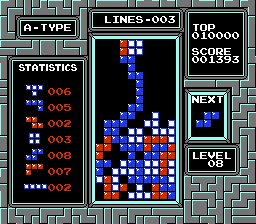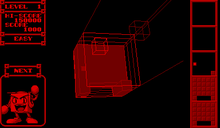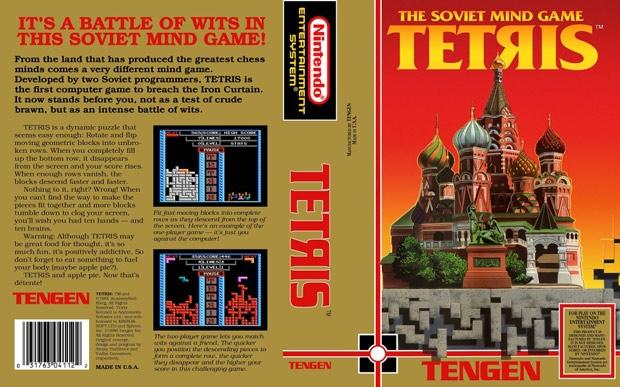By John Tustin
Originally released on June 6th 1984 on the Nintendo Entertainment System, Tetris is a high-score oriented puzzle game created by Alexey Pajitnov. Chances are that you’ve heard of Tetris, and probably even played it. Since 1987 Tetris has been rereleased on countless platforms, a large contributing factor on why for such a long time it was the best selling video game of all time and ranks third now. When I saw Tetris has been released on countless platforms I mean variants have been released on every major game console ever, truly making it a timeless classic, still being rereleased 37 years after its release. There’s usually some minor changes (and in some cases, drastic changes) included in each release, but at its core, it’s still Tetris. You’re almost definitely familiar with the gameplay, but on the slim chance you’re not, here’s a brief summary.
Blocks called “Tetriminos” fall from the sky onto a board that’s typically 10×20 blocks (in terms). There are a total of 7 Tetriminos that each have their own shape, each comprising of 4 blocks in total. The goal of the game is to last as long as possible without having the Tetriminos reach the roof of the board, while also getting as many points as possible. When a player gets an entire horizontal row of blocks to reach both sides of the board with no gaps, said row will disappear, making all the Tetriminos above it shift down by a one block space. This allows the player to gain points depending on how many rows at a time are cleared.
If you manage to clear four of those rows at the same time, then you will get the aptly named “tetris”. There are only two moves to the whole game, that being “Rotating” and “Holding”. Rotating of course allows you to rotate each Tetrimino, in 4 directions. Holding allows you to store one Tetrimino at a time and call on it whenever you want, though when a Tetrino is called out of holding, it cannot be put back. The more lines you clear, the faster the game drops the Tetriminos, up to a certain speed. (Note: You can usually see which Tetriminos are going to drop next, but the number you can see varies on each version).
Despite my complex explanation, Tetris is a really simple and intuitive game. There’s a reason why it’s been rereleased so many times. It’s simple yet fun, and appeals to people of all ages. And because of it’s simple core gameplay there have been many different spin offs from the franchise. There are games that have the board be a cube or a sphere, a game that makes you workout, and even a game that’s a battle royale. There are a lot of iterations of this one game, but for the most part Tetris games are just the same old thing with a new coat of paint. Which isn’t a bad thing. There’s a reason why Tetris has remained largely unchanged since it’s initial release and why the more drastic changes never stick … and that’s because Tetris is the perfect game.
Now, before you get mad at me, hear me out. Tetris isn’t the best game in the world, hell, it isn’t even my favorite game. I know everything is subjective, but through an objective lens, Tetris is the perfect game. Tetris never ends, there is no set campaign, different levels, or timer. What differentiates each new session from the last is the randomness of the Tetriminos you get, how you place them, which blocks you hold, and if you add to all that the large playing area of the board, you can never really repeat the same match of Tetris. How each session goes depends on two very important factors in video games—the player and the RNG—but mostly the player.
Unlike other high score-based games of its time like Pac Man and Donkey Kong, which loop after a certain point, Tetris never gets old. Now I know you might be thinking “Aren’t you staring at the same board every game?” And yes, you’re correct. But strangely enough Tetris still doesn’t get old, for as I mentioned before, it’s all about the player. Because there’s no pattern, rhythm, or rhyme in this game, the player can never get comfortable with it. The Tetriminos you get are random and you actively have to use your brain to decide where it would best fit. A pro-player would try to determine whether it’d be best to replace the current Tetrimino with the one they’re holding, and if that one would fit, then if the Tetrimino that is coming up is going to fit nicely on the board with the next move that is made.
In reality, you can play however you want, without needing to need to think that far ahead. You can turn off your brain and instinctively place each Tetrimino, you can try to set up getting a tetris for every “clear” you get, or you can clear a single line at a time. There’s a ton of different perspectives on ways to play the game, so there’s no one set way to enjoy it. And the beauty of it is that Tetris never gets boring (although that judgement is subjective, it seems proven by the fact that for the most part, the public always seems to play Tetris).
Another factor that plays into Tetris’s perfection is how time works within it. After a certain number of clears the game shifts into the next “level” which speeds up how fast the Tetriminos drop, increasing until it reaches a speed where the Tetriminos practically form on the board rather than “drop,” with just enough time to keep it classified as “dropping” the Tetriminos. The levels change very gradually, making you periodically notice how fast the game has gotten. Then, once the game reaches the fastest speed it can go, it’s not something that instantly loses you the game. It’s really freaking hard, but you can manage to keep on playing.
The average player will never be able to master Tetris when it’s running at its maximum speed, but they can get really good, and that’s part of the beauty of this game. Pro-players are used to this speed, but since such people are practically superhuman with their reflexes we should ignore them for now. Whenever Tetris reaches the max speed, you can no longer plan out your moves. This makes you rely purely on your brain’s reflexes and instantaneous puzzle solving abilities, which in a strange way makes the game really gratifying. This is the perfect difficulty cap for a video game. Plus, by not allowing you to keep playing at any set speed, Tetris forces you to get better in a way that makes it never get old. Tetris is the perfect game. It doesn’t alienate any one player. Tetris relies on the players to create unique gameplay for themselves. It’s extremely simple to play, yet has enough moving parts to it to allow for strategic gameplay. Mentally it’s extremely satisfying to play, even being known to relax people. It’s a game that never ends, a game that gets you to be better at it with every session you play. There are reasons why this game simply won’t die unlike it’s former companions. You don’t see Frogger, Asteroids, or Space Invaders being rereleased every console generation. Tetris became the perfect game because it is able to make so much of so little.
The game’s creator evidently agrees, saying: “I think that’s what makes the game so addictive. We have an inherent desire to create order out of chaos, and Tetris satisfies that desire on a very basic level, while being easy to understand and quick to learn.” – Alexey Pajitnov (Creator of Tetris)


